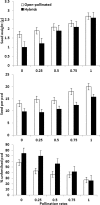Scarcity of ecosystem services: an experimental manipulation of declining pollination rates and its economic consequences for agriculture
- PMID: 27441108
- PMCID: PMC4941739
- DOI: 10.7717/peerj.2099
Scarcity of ecosystem services: an experimental manipulation of declining pollination rates and its economic consequences for agriculture
Abstract
Ecosystem services (ES) such as pollination are vital for the continuous supply of food to a growing human population, but the decline in populations of insect pollinators worldwide poses a threat to food and nutritional security. Using a pollinator (honeybee) exclusion approach, we evaluated the impact of pollinator scarcity on production in four brassica fields, two producing hybrid seeds and two producing open-pollinated ones. There was a clear reduction in seed yield as pollination rates declined. Open-pollinated crops produced significantly higher yields than did the hybrid ones at all pollination rates. The hybrid crops required at least 0.50 of background pollination rates to achieve maximum yield, whereas in open-pollinated crops, 0.25 pollination rates were necessary for maximum yield. The total estimated economic value of pollination services provided by honeybees to the agricultural industry in New Zealand is NZD $1.96 billion annually. This study indicates that loss of pollination services can result in significant declines in production and have serious implications for the market economy in New Zealand. Depending on the extent of honeybee population decline, and assuming that results in declining pollination services, the estimated economic loss to New Zealand agriculture could be in the range of NZD $295-728 million annually.
Keywords: Brassica; ES; Economic value; Pollination rate; Pollination scarcity; Seed production.
Conflict of interest statement
Harpinder Sandhu and Steve Wratten are Academic Editors at PeerJ.
Figures



Similar articles
-
Crop production in the USA is frequently limited by a lack of pollinators.Proc Biol Sci. 2020 Jul 29;287(1931):20200922. doi: 10.1098/rspb.2020.0922. Epub 2020 Jul 29. Proc Biol Sci. 2020. PMID: 33043867 Free PMC article.
-
Contribution of insect pollinators to crop yield and quality varies with agricultural intensification.PeerJ. 2014 Mar 27;2:e328. doi: 10.7717/peerj.328. eCollection 2014. PeerJ. 2014. PMID: 24749007 Free PMC article.
-
Insect pollinated crops, insect pollinators and US agriculture: trend analysis of aggregate data for the period 1992-2009.PLoS One. 2012;7(5):e37235. doi: 10.1371/journal.pone.0037235. Epub 2012 May 22. PLoS One. 2012. PMID: 22629374 Free PMC article.
-
The Dependence of Crops for Pollinators and the Economic Value of Pollination in Brazil.J Econ Entomol. 2015 Jun;108(3):849-57. doi: 10.1093/jee/tov093. Epub 2015 May 4. J Econ Entomol. 2015. PMID: 26470203 Review.
-
Global pollinator declines: trends, impacts and drivers.Trends Ecol Evol. 2010 Jun;25(6):345-53. doi: 10.1016/j.tree.2010.01.007. Epub 2010 Feb 24. Trends Ecol Evol. 2010. PMID: 20188434 Review.
Cited by
-
Field-realistic concentrations of a neonicotinoid insecticide influence socially regulated brood development in a bumblebee.Proc Biol Sci. 2022 Nov 30;289(1987):20220253. doi: 10.1098/rspb.2022.0253. Epub 2022 Nov 16. Proc Biol Sci. 2022. PMID: 36382527 Free PMC article.
-
Pollination benefits are maximized at intermediate nutrient levels.Proc Biol Sci. 2017 Aug 16;284(1860):20170729. doi: 10.1098/rspb.2017.0729. Proc Biol Sci. 2017. PMID: 28794217 Free PMC article.
-
Scarcity Value Assessment of Ecosystem Services Based on Changes in Supply and Demand: A Case Study of the Yangtze River Delta City Cluster, China.Int J Environ Res Public Health. 2022 Sep 22;19(19):11999. doi: 10.3390/ijerph191911999. Int J Environ Res Public Health. 2022. PMID: 36231297 Free PMC article.
-
Bee pollination outperforms pesticides for oilseed crop production and profitability.Proc Biol Sci. 2019 Oct 9;286(1912):20191550. doi: 10.1098/rspb.2019.1550. Epub 2019 Oct 9. Proc Biol Sci. 2019. PMID: 31594515 Free PMC article.
References
-
- Albrechdt M, Duelli P, Müller C, Kleijn D, Schmid B. The Swiss agri-environment scheme enhances pollinator diversity and plant reproductive success in nearby intensively managed farmland. Journal of Applied Ecology. 2007;44(4):813–822. doi: 10.1111/j.1365-2664.2007.01306.x. - DOI
-
- Barrionuevo A. Honeybees vanish, leaving keepers in peril. The New York Times. 2007. http://www.nytimes.com/2007/02/27/business/27bees.html http://www.nytimes.com/2007/02/27/business/27bees.html
LinkOut - more resources
Full Text Sources
Other Literature Sources

